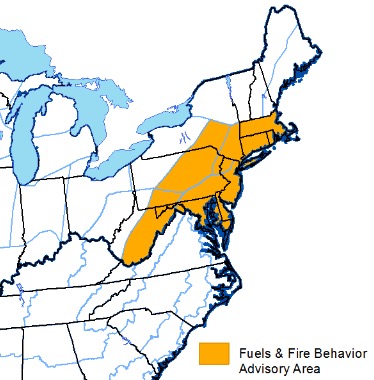A Predictive Services unit wrote this Fuels and Fire Behavior Advisory — it’s not clear which one, regional or national. It was distributed by the National Interagency Coordination Center. Our view is that if you are distributing an important directive and calling for action, the person, or at least the unit, that analyzed the data and developed the recommendations should be identified. This is not the place for anonymity.
Fuels and Fire Behavior Advisory
Southeastern Halves of New England/Mid-Atlantic States
April 24, 2016
Subject: Fuel conditions/elevated significant fire potential across the southeastern halves of New England and Mid-Atlantic states.
Discussion: Short to medium range drought developed across the southeastern halves of New England and the Mid-Atlantic States through the second half of March into April 2016. Calculated 1000 hour fuel moisture levels at many RAWS across these areas were below 17% and 100 hour fuels below 10%. NFDRS Energy Release Components and Burning Indices were well above the 90th percentile as well. These conditions have led to periods of above normal fire potential across portions of the Northeast and Mid-Atlantic late March through April of 2016 during dry and windy periods.
Fire behavior reports from fires occurring near and within the areas of concern through mid-April indicated rapid rates of spread. Abnormal nighttime fire activity was also reported on some of the fires creating suppression problems and increased fire size. While the main driver of fire occurrence and behavior was fine fuels, 100 and 1000 hour fuels were also receptive to ignition and some consumption, leading to more intense and persistent fires. Until rainfall increases over these areas, elevated fire potential and problematic fire behavior is likely during any dry and windy periods into May 2016.
Difference from normal conditions: Calculated NFDRS indices and fuel moistures from various RAWS across the areas of concern were at or approaching extreme levels or the 97th percentile. Prolonged periods of minimum RH levels were observed through mid-April significantly drying out fuels.
Concerns to Firefighters and the Public:
- Anticipate any ignition in flashy fine fuels to burn readily and move rapidly during periods of dry and windy weather conditions.
- Anticipate heavier fuel involvement where 1000 and 100 hour fuel moistures have dropped to critical levels.
Mitigation Measures:
- Make certain firefighters have good anchor points and keep one foot in the black.
- Ensure LCES is in place on every fire before engaging. Lookouts should have a good understanding of the effects of weather changes and topography on fire behavior.
- Become familiar with local fuel conditions and current fire danger indices, and their implications for fire behavior.
Area of Concern: Southeastern Halves of New England/Mid-Atlantic States.

Nice to see the elevated risk ends at the Virginia border. That might tell you which regional office produced the report right there. Meanwhile I’ve never seen leaf litter burn quite as hot as it has been doing in the Old Dominion. It’s almost acting like a grass group.